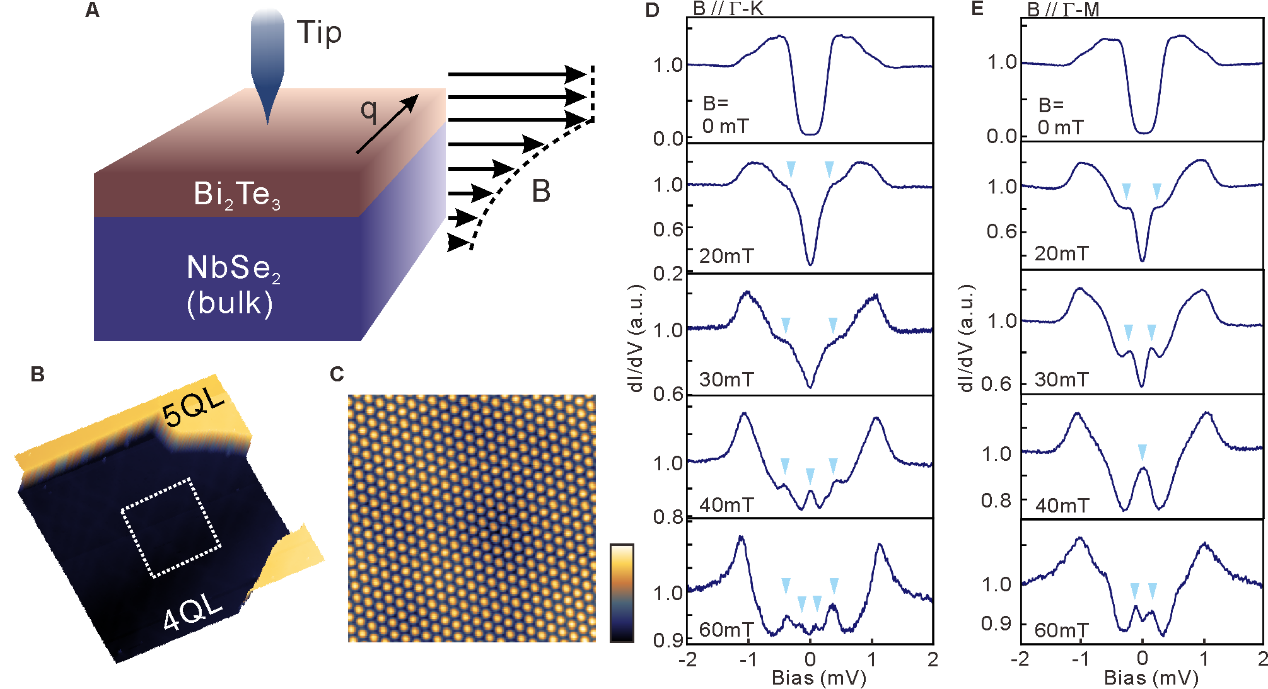
An international team led by Prof. Hao Zheng and Prof. Jinfeng Jia in the School of Physics and Astronomy and the Tsung-Dao Lee Institute at Shanghai Jiao Tong University has successfully detected the segmented Fermi surface induced by the Cooper pair momentum in a Bi2Te3/NbSe2 system by ultra-low temperature scanning tunneling microscopy. The paper was published online as First Release by Science on October 29, 2021 Beijing time. (https://www.science.org/doi/10.1126/science.abf1077 )
The density of states (DOS) near the Fermi surface determines various physical properties of materials, like electrical conductivity and transmission of light etc. Tuning the DOS at the Fermi level can drastically change the physical properties of a material. Therefore, the direct experimental manipulation of the Fermi surface is a powerful tool for the engineering of materials.
The study of superconductivity is a long-standing research topic in physics because of the novel properties of superconductors, such as zero-resistance conductivity and perfect diamagnetism. Generally, due to the existence of the superconducting energy gap at the Fermi level, no superconductor has a Fermi surface. As early as 1965, Fulde predicted theoretically that quasiparticles could be created in a superconducting energy gap if the momentum of the Cooper pair in a superconductor was large enough, which will lead to a special "segmented Fermi surface" [Phys. Rev. 137, A783-A787 (1965)]. However, it is very difficult to observe this "segmented Fermi surface" experimentally because when there is momentum large enough to produce quasiparticles, it may result in the breaking of the Cooper pairs and the loss of superconductivity.

Fig. 1 A. Schematic diagram of a Bi2Te3/NbSe2 superconducting heterojunction. B. Morphology of a high quality Bi2Te3 film grown on NbSe2. C. Atomic resolution image of Bi2Te3 film. D, E. The signal from quasiparticles gradually increases in the tunneling spectrum under the influence of in-plane magnetic fields of different magnitude and orientation.
The research team has overcome this problem by considering a four-layer thick film of the topological insulator Bi2Te3, which was grown on the surface of the superconductor NbSe2 by molecular beam epitaxy. In this system, due to the large Fermi velocity of the Bi2Te3 surface state (see Figure 1A), the Cooper pair momentum induced energy in the Bi2Te3 surface state is already large enough to generate quasiparticles even when the energy in the NbSe2 is still small. This allows the generation of a small superconducting current on the NbSe2 surface with a small horizontal magnetic field. At this point, the Cooper-pair momentum in the Bi2Te3 surface state is sufficient to generate quasiparticles and lead to the emergence of segmented Fermi surfaces.
The experimental apparatus in this study is a scanning tunneling microscope equipped with a dilution refrigerator and a vectorial magnetic field. As shown in Figure 1, the Cooper pair momentum increases as the magnetic field increases, and more and more quasiparticles are generated within the superconducting energy gap (the DOS increases at the bottom of the energy gap, see Figure 1D and Figure 1E), heralding the gradual creation of segmented Fermi surfaces in a superconductor.

Fig. 2 A to C and G to I, standing wave patterns generated in real space under a magnetic field of 40 mT along the Γ-K and Γ-M directions, respectively. D to F and J to L. The corresponding Fourier transforms of A to C and G to I, which produce quasiparticle interference signals dependent on the direction of the magnetic field.
Going a step further, they have observed standing waves in real space using quasiparticle interference techniques (see Figures 2A-C, G-I), and confirmed the creation of a Fermi surface at zero energy by Fourier transform. Remarkably, the Fermi surface is composed of part of a non-superconducting Bi2Te3 Fermi surface, and its shape and orientation can be determined by the strength and direction of the applied magnetic field (see Fig. 2D-F, J-L), which is fully consistent with the theoretical prediction for the segmented Fermi surface
This work utilizes topological insulator/superconductor heterojunctions to observe experimentally for the first time the segmented Fermi surface predicted theoretically more than 50 years ago. Moreover, by changing the direction and magnitude of the magnetic field, it is possible to modify the shape and size of the Fermi surface which has many potential applications including the design of new superconductors with tunable topological features. It opens new research avenues in the control and manipulation of crystals.
Dr. Zhu Zhen of SJTU and Dr. Papaj of MIT are the co-first authors of this paper, Prof. Hao Zheng and Prof. Jinfeng Jia of SJTU and Prof. Liang Fu of MIT are the corresponding authors of this paper. This work was supported by the Ministry of Science and Technology of China, NSFC, the Strategic Priority Research Program of Chinese Academy of Sciences, the Science and Technology Commission of Shanghai Municipality and the China Postdoctoral Science Foundation.




